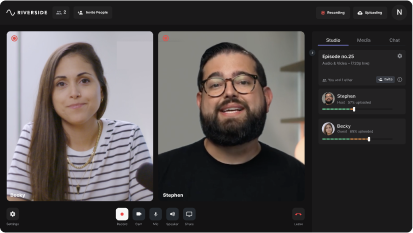Last Updated
February 5, 2023
Joint Stereo vs Stereo: What's the Difference & Which is Best

Even if you’re a prolific audio creator, the technicalities of joint stereo vs stereo may escape you. And you’re definitely not alone. But since the choice between stereo and joint stereo can sometimes impact your overall audio quality, it’s good to know what you’re talking about. This guide explains the difference between joint stereo and stereo and outlines which is the better choice depending on your priorities.
TL;DR
- Stereo is where sounds have been recorded onto two channels: Left and Right.
- Joint Stereo is an ‘optimized’ version of stereo which results in a smaller file size.
- The choice between joint stereo and stereo depends on your needs and priorities.
- Generally speaking, mono is actually a more straightforward choice for solo or dialogue-based podcasts.
Key terms
In order to understand stereo and joint stereo, you need to know what a few essential terms mean:
KPBS
Kbps stands for ‘kilo-bits per second’ and is an essential metric for audio quality. The higher your kbps, the higher quality your audio will be. Your sound file’s audio bitrate will be measured in kbps.
Audio encoding
Audio encoding is how audio is converted into a digital format. You can get audio that is encoded to be uncompressed or compressed.
What is Stereo and Joint Stereo?
Before we investigate the differences between stereo and joint stereo, let’s take a look at what they both refer to:
Stereo
So, what does stereo mean? Stereo or stereophonic sound is audio where both the left and right channels have been encoded separately into an audio file. This results in a higher bitrate (aka higher sound quality) overall.
Generally speaking, this ‘two channel’ integration is thought to result in a better experience for the listener because of the ‘multi-dimensional’ effect that stereo creates.
Stereo is recommended if you are encoding audio at a bitrate of 256 kbps or higher.
Joint Stereo
Joint stereo is considered an ‘optimized’ version of stereo because joint stereo files take up less space. Joint stereo tries to cut down on any data that is unnecessarily encoded by combining L and R channels into what is called a ‘mid channel’. Then, when you encode your joint stereo file, the encoder will ‘average’ out the L & R channels, resulting in a smaller file.
Joint stereo is intended for when you want to encode audio that is less than 256 kbps.
Joint stereo can be encoded using one of two methods:
Intensity Stereo
Intensity stereo is where joint stereo audio is encoded into a mono channel. This method leverages the fact that minor differences or audio imperfections are imperceptible to human ears. Thus intensity stereo is what is known as a ‘lossy’ encoding method and should be used for audio that has a low bit rate.
Mid/side stereo
Mid/side stereo, sometimes referred to as ‘sum/difference’, encodes joint stereo audio using two channels. The first ‘Middle Channel’ encodes any information that is identical on both the L and R channels. The second ‘Side Channel’ encodes any differences in the audio on each channel.
Mid/side stereo does not sacrifice any information, meaning it is a lossless encoding method.
The differences between stereo and joint stereo
As we’ve seen, stereo and joint stereo are slightly different. Whilst stereo audio files are where the left and right channels have been encoded separately, joint stereo aims to reduce the overall file size either by combining the two channels or by encoding the similarities and differences separately.
As a result, joint stereo saves space and makes for a smaller file size. However, this does mean it has a lower bitrate when compared to stereo. On the flip side, stereo files tend to be much bigger meaning you’ll lose out on storage space.
Joint stereo vs stereo: Why does it matter?
The choice between joint stereo vs stereo is entirely personal. Depending on whether you’re looking to save on storage space or are focussed on preserving as much audio quality as possible, your priorities will dictate the best choice for you.
Is joint stereo better quality than stereo?
Depending on the original audio recording, choosing one over the other may not result in a discernible difference. If there is a big difference between the two channels, then stereo may produce a more high-fidelity and natural soundscape than joint stereo.
Joint stereo is generally the better choice when you’re dealing with lower bit rates. Especially since it optimizes for storage.
However, it’s important to note that the tools you’re using (aka your encoder) make a big difference since audio quality can also be significantly impacted by the codec used. On the flip side, if you have a good media encoder, you may not even notice much of a difference between joint stereo and stereo files.
How to choose the right stereo for your podcast
Although we don’t want to confuse things, stereo isn’t always the best format choice for podcasting. If you’re creating a solo podcast where just the host is speaking, or there’s a lot of dialogue between the host and guest speakers, mono can be the best choice. This is because for this kind of recording, mono results in smaller files whilst still offering good audio quality.
Stereo, on the other hand, is better suited to podcasts in which sounds other than people’s voices play a big part. This means if you’re including a lot of music or other media effects and want to differentiate the audio coming into the left versus right ear, stereo is a better choice.
FAQs on Joint Stereo vs Stereo
Is joint stereo mono?
Joint stereo is not mono. Joint stereo is an encoding method that maintains the stereo effect of having two channels, whilst saving space.
As we saw, there are two encoding methods used for joint stereo. One of which (intensity) encodes the L and R channels into one. However, if it is M/S stereo, this means that your recording has been encoded onto a ‘Middle’ and ‘Side’ channel.
How to convert a stereo file to a joint stereo file?
It’s not actually possible to convert a stereo file into a joint stereo file. Instead, what you should do is go back to your original recording and export it in joint stereo format.
What does Joint Stereo mean in Logic?
In Logic, users have the option to ‘bounce’ their audio files to MP3 format. You can choose what stereo mode you want, whether that’s joint or normal stereo.
What is joint stereo in Itunes?
When you import music and audio into Apple Music (formerly known as iTunes), you can toggle your import settings to match your preferences. Within this, you can set your custom import settings for using an MP3 Encoder. Here you can choose which ‘Stereo Mode’ you want: normal or joint stereo.
Choosing Joint Stereo mode means that you set your MP3 encoder to encode your audio as M/S Stereo in which the middle channel ‘carries the information that’s identical on both channels’ and the ‘other channel carries the unique information.’
What's the difference between mono and stereo?
Put simply, mono audio has just one single channel whereas stereo has two. Mono audio is where all sound has been recorded onto the same channel, whereas stereo separates the audio onto L and R channels.
What is dual stereo?
If you’re asking what dual stereo is, then you might be getting confused with dual-mono. Stereo refers to audio that has been recorded across two different but related channels. Dual mono, by contrast, refers to two completely separate and independent channels that are played at the same time.
Should I use joint stereo?
It depends on what you’re looking for. As we’ve seen, joint stereo and stereo offer various advantages and disadvantages. Joint stereo is great if you’re looking to save on storage whilst still maintaining good (but not necessarily the best) audio quality.
Can MP3 have more than 2 channels?
MP3 file formats can either be mono or stereo, meaning it can support up to two channels. MP3 Surround is an extension of the MP3 file format and can support up to 5.1 channels.
What is joint channel encoding?
Joint encoding is where multiple channels are joined together during the encoding process.















.png)


 (1).webp)
.webp)
.webp)








